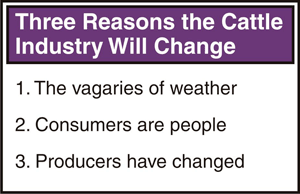
Kris Ringwall
Beef Talk
Who said change would be easy?
Is the cattle industry really changing? The industry may or may not be changing, but at the Dickinson Research Extension Center (REC), the cow business has changed. Business as usual is no longer around.
Why? That is what the Dickinson REC has set out to resolve. There are three or more key points.
Three reasons
The first is the vagary of weather. Cattle require feed, and weather encourages or denies feed. Currently, denial has the upper hand. Producers simply cannot muster enough feed to logically expand the cow herd.
 The second key point is that consumers are people. Peoples' living habits have changed. Once the taboo of utilizing food products for other living desires was accepted, cattle now compete directly for input resources. Thus, feed costs are accelerating faster than expected product value. The cow herd will not expand without the opportunity for profit.
The second key point is that consumers are people. Peoples' living habits have changed. Once the taboo of utilizing food products for other living desires was accepted, cattle now compete directly for input resources. Thus, feed costs are accelerating faster than expected product value. The cow herd will not expand without the opportunity for profit.
Producers have changed is the third key point. In the labor-intensive cow business, help is difficult to find. Cattle systems must be profitable and must be doable.
We accept the weather, acknowledge people and research new ways to help producers align the beef business with current and future culture. As the culture changes, so do food preferences. As food changes, so do cattle.
Response to change
The center can respond. However, to respond, the center needed to change. In response to the issues of weather, the center continues to expect cattle to survive the vagaries of weather. Cows are not pampered, and human intervention facilitates herd health and individual care only when indicated.
Consumers are predictable, but the ramifications of a consumer choice may not be known because the data may not exist until after the choice. Perhaps that is the situation as multiple players bid for corn or other input resources traditionally reserved for cattle.
In response, the center has shifted to explore new cattle resources and inputs that may not directly compete with human desires. This response acknowledges industry change and seeks to create a new environment here at the center designed to create a research, extension and teaching opportunity that addresses issues within the industry. The change has not been easy or totally predictable.
As the Dickinson REC shifts from a grain-based beef production model to a grass-based beef production model, future projects will be designed and implemented that will provide data to evaluate industry questions. The future certainly is not easy to predict, but moving forward based on sound research is critical.
Consumers are predictable, but the ramifications of a consumer choice may not be known because the data may not exist until after the choice.
Many issues, such as appropriate cow size and bull genetics, need to be addressed as the center evaluates various grass systems of production. The additional concerns of cattle temperament on grass, handling systems and effects on carcass merit also will be discussed and evaluated where possible.
Ultimately, final beef products will be harvested, processed, prepared and evaluated by the consumers. Although some of the questions may be evaluated reasonably soon, the production data will need to be combined with fiscal data to fully evaluate any economic and financial opportunities the grass-based beef production model may offer that the current grain-based beef production systems do not. Efforts to understand new beef production systems to create added demand and value for beef products are critical.
Several years back, the article "The Future of Animal Agriculture in North America," found in the electronic Choices magazine (http://www.choicesmagazine.org, Volume 21, No. 3, 2006) was published by the American Agricultural Economics Association.
The series of articles identified issues that ultimately will shape our industry, including issues such as markets, structure and competition; value in integrated markets and consumer demand; global competitiveness; environmental concerns and regulations; community concerns and labor; food safety and animal health; and the welfare and care of animals.
Those same issues still remain and the future foundation of the beef business will be interwoven around our ability to resolve the issues identified. One thing we do know: Ultimately, the future evolves as a very slow process that converts issues to change and involves three fundamental principles.
For any futuristic action or solution to become a reality, the action must be sensible and sustainable, and reflect good stewardship. For now, the center is changing. As difficult as it is, the center will again ask: Why?
May you find all your ear tags.
 Your comments are always welcome at www.BeefTalk.com. For more information, contact the North Dakota Beef Cattle Improvement Association (NDBCIA) Office, 1041 State Ave., Dickinson, ND 58601, or go to www.CHAPS2000.com on the Internet.
Your comments are always welcome at www.BeefTalk.com. For more information, contact the North Dakota Beef Cattle Improvement Association (NDBCIA) Office, 1041 State Ave., Dickinson, ND 58601, or go to www.CHAPS2000.com on the Internet.










